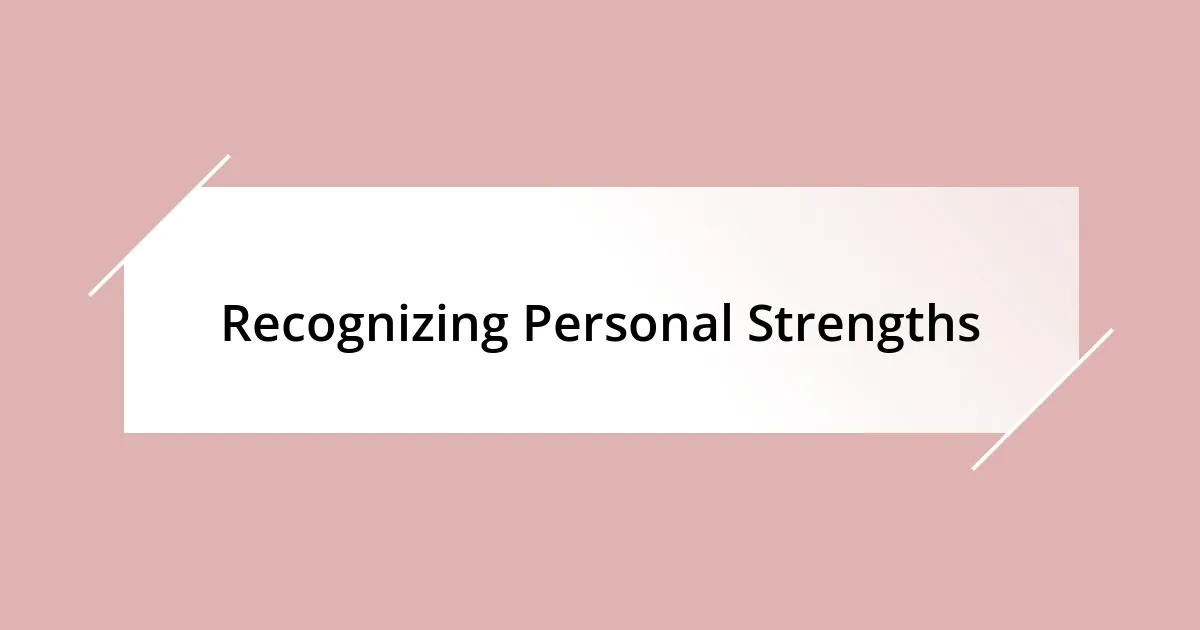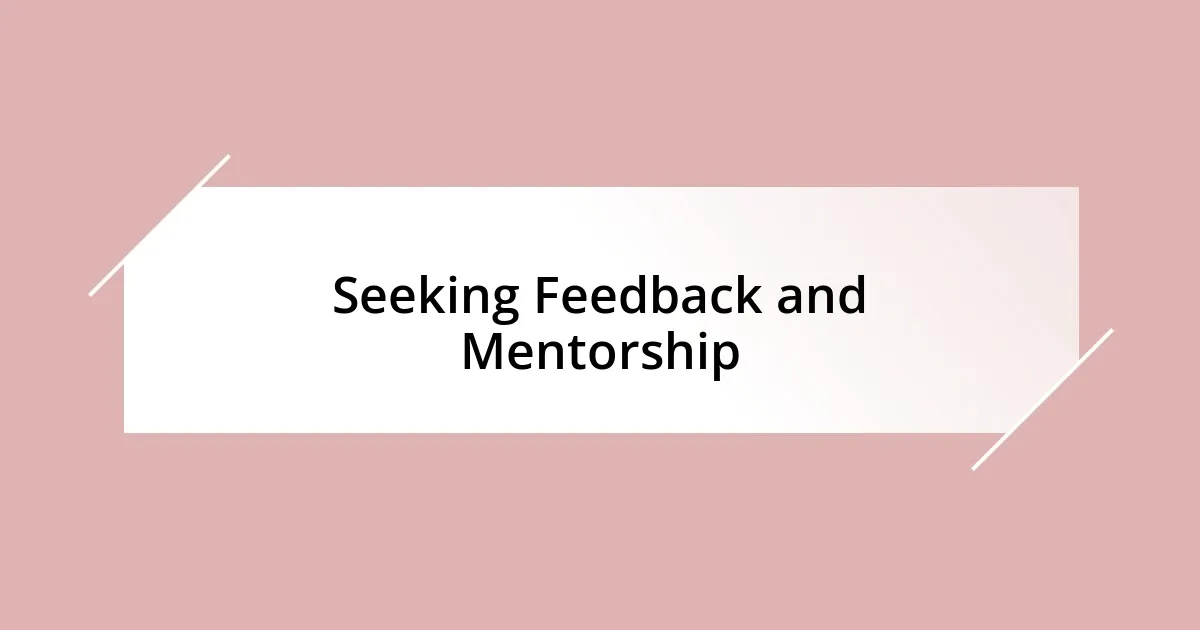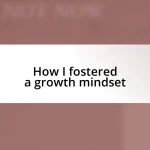Key takeaways:
- Empathy and emotional intelligence are vital for connecting with and inspiring team members during stressful situations.
- Decisiveness and effective communication are crucial leadership qualities that foster trust and alleviate team anxiety.
- Seeking feedback and mentorship helps leaders grow by providing insights into their strengths and weaknesses.
- Regular reflection on leadership experiences and decision-making enhances self-awareness and promotes continuous improvement.

Understanding Leadership Qualities
Understanding leadership qualities goes beyond mere titles or positions; it’s about embodying characteristics that inspire and motivate others. I remember a time when a stressful project pushed my team to the brink. It was in that moment that I realized the importance of empathy – understanding my team’s struggles allowed me to connect with them on a deeper level. Isn’t it fascinating how emotional intelligence can transform the dynamics of group work?
Another facet I’ve come to appreciate is decisiveness. I recall a particularly challenging situation where we had to choose between two critical options, and I felt the weight of my team’s uncertainty resting on my shoulders. Making a clear decision not only relieved their anxiety but also reinforced my role as a leader. How often do we let the fear of making the wrong choice hold us back from taking action?
Finally, I often reflect on the power of effective communication. Early in my journey, I noticed that the most successful leaders I admired were those who could articulate their vision compellingly. I’ve learned that sharing my thoughts clearly fosters trust and invites collaboration. Isn’t it incredible how a few well-chosen words can rally a whole team toward a common goal?

Recognizing Personal Strengths
Recognizing personal strengths is a pivotal step in developing authentic leadership qualities. I’ve found that regular self-reflection allows me to identify the traits that serve me best. For instance, during a feedback session, I was surprised to learn that my ability to remain calm in crisis situations was highly valued by my colleagues. This realization not only boosted my confidence but also encouraged me to leverage this strength more actively in stressful times.
To effectively recognize your personal strengths, consider these strategies:
- Seek Feedback: Ask trusted colleagues or friends how they see your strengths.
- Self-Assessment: Use tools like personality tests or strength inventories to gain insight.
- Reflect on Achievements: Think about past successes and the skills you utilized in those moments.
- Keep a Journal: Document daily experiences to notice patterns in your reactions and decisions.
- Experiment: Try new roles or tasks to uncover hidden strengths that may surprise you.
By pinpointing these qualities, I feel more empowered to lead effectively and authentically.

Seeking Feedback and Mentorship
Seeking feedback and mentorship is like holding a mirror to your leadership journey. In my experience, inviting others to share their perspectives on my leadership style revealed invaluable insights. For instance, a mentor once pointed out that my tendency to rush through problem-solving often left my team feeling unheard. This feedback wasn’t easy to swallow initially, but it encouraged me to slow down, listen actively, and ultimately foster a more inclusive environment. Have you ever received feedback that changed your approach?
Mentorship has played a crucial role in my development as a leader. I recall a mentor who shared their own struggles during tough times, reminding me that vulnerability often precedes growth. Their guidance taught me the importance of being open about challenges, which helped me connect with my team on a more profound level. It’s fascinating how sharing our journeys, including failures, can inspire others to push through their own hurdles.
Here’s a look at the differences between seeking feedback and actively engaging with a mentor:
| Feedback Seeking | Mentorship |
|---|---|
| Focus on immediate performance | Long-term development |
| Often unsolicited | Typically guided and structured |
| Can be formal or informal | Usually a mutual relationship |
| Results can be quick improvements | Results take time and commitment |

Setting Clear Goals for Development
Setting clear goals is the compass for my development journey. When I first started identifying my leadership aspirations, I felt overwhelmed; it was like trying to navigate without a map. I learned that breaking down my long-term ambitions into smaller, achievable milestones made the process manageable. For instance, aiming to improve my public speaking skills led me to set a goal of delivering a presentation once a month. This not only built my confidence but framed my path forward with tangible steps.
I remember setting a goal to enhance my emotional intelligence, which was quite challenging at first. It started with recognizing my triggers in stressful situations and committing to respond more thoughtfully. I kept track of my interactions in a journal, and little by little, I noticed a shift. Has striving for emotional growth also been a part of your leadership journey? It was eye-opening to see how refining one aspect of my leadership developed my overall effectiveness.
Furthermore, I found that writing down my goals and revisiting them frequently created a sense of accountability. Each time I crossed a goal off my list, I felt an invigorating sense of accomplishment. It wasn’t just about personal achievement; it became a motivator to encourage others around me to pursue their goals too. In what ways do you reflect on your progress? For me, celebrating small wins acted as a fuel that powered my development and inspired my team to chase their ambitions.

Practicing Decision Making Skills
Practicing decision-making skills has been a transformative part of my leadership development. I remember facing a situation where my team had to choose between two competing projects, each with strong arguments for their viability. I gathered the team for a discussion, encouraging everyone to share their thoughts, which not only made the group feel valued but also highlighted different perspectives that I hadn’t considered. Have you ever found the best decisions emerge when everyone contributes?
As I navigated through various decision-making scenarios, I learned the significance of gathering data while also trusting my intuition. On one occasion, I relied strictly on analytics, and it led me down a path that felt sterile and one-dimensional. The next time, I balanced data with gut feelings and insights from my team, which led to a much more nuanced and successful outcome. It made me realize that good leaders adapt their approach to include both quantitative and qualitative factors, don’t you agree?
Moreover, I started reflecting on my decision-making process regularly, which was an eye-opener. After making pivotal choices, I began to analyze what worked and what didn’t. One time, I decided to take a risk on an innovative idea that initially seemed far-fetched. After assessing the outcome, I realized that the willingness to embrace uncertainty could lead to remarkable breakthroughs—or valuable lessons. This practice of reflection not only sharpened my decision-making skills but also empowered me to lead my team in taking calculated risks. How often do you leave room for reflection in your decision-making?

Building a Supportive Network
Building a supportive network has been an essential aspect of my leadership journey. Early on, I realized that surrounding myself with individuals who inspire and challenge me was crucial. I recall attending a conference where I connected with a mentor who introduced new perspectives and encouraged me to step outside of my comfort zone. Their belief in my potential made a significant difference—have you ever had someone spark that same transformative belief in you?
As I navigated through various professional experiences, I made a conscious effort to nurture my relationships. I invested time in regular catch-ups with colleagues, providing support and collaboration opportunities. One memorable moment was when a coworker faced a tough project deadline; I offered an afternoon to brainstorm ideas. This shared experience not only strengthened our bond but also fostered a sense of camaraderie. Could it be that these acts of kindness create a ripple effect of encouragement in our professional lives?
I firmly believe that the quality of relationships I cultivate directly influences my growth as a leader. Seeking out diverse viewpoints has enriched my understanding and decision-making. For instance, when I joined a leadership group comprised of individuals from various industries, I felt an invigorating shift. Collaborating with them opened my eyes to creative problem-solving strategies I hadn’t considered before. It begs the question: how often do you engage with diverse voices to challenge your own thinking? By building a supportive network, I’ve found that I’m not just growing; I’m thriving alongside others who share this path.

Reflecting on Leadership Experiences
Reflecting on my leadership experiences has often been a powerful catalyst for growth. I remember a time when I led a community project that didn’t go as planned. Instead of feeling defeated, I took a step back to analyze what happened. I realized that my initial enthusiasm had clouded my judgment, and I failed to engage the team adequately. It struck me—how often do we let passion overshadow the importance of collaboration?
Through these reflections, I started to appreciate the lessons embedded in each setback. One insightful moment came after a particularly challenging presentation where I stumbled over my words. Instead of pushing it aside, I sought feedback from my colleagues, learning from their perspectives. It made me question how vulnerability can be a strength in leadership. Have you ever turned a mistake into a stepping stone for learning?
As I continued this practice, I discovered that carving out time for reflection was essential for my development. Journaling became my go-to strategy; it transformed chaotic thoughts into clear insights. I remember jotting down goals and the emotions tied to each experience, which helped me see patterns in my decision-making and my growth areas. Reflecting this way prompted me to ask—could it be that self-awareness is the secret ingredient to effective leadership? In my journey, I’ve found that reflecting on my experiences doesn’t just improve my skills; it deepens my understanding of who I am as a leader.














